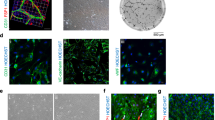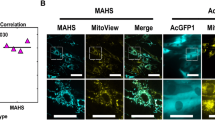Abstract
Porcine mesenchymal stem cells (MSCs) are similar to human MSCs, hence considered a valuable model for assessing potential for cell therapy. Porcine adipose-derived MSCs (AD-MSCs) and endometrial stromal MSCs (EMSCs) displayed fibroblast-like morphology and were positive for MSC markers CD73, CD90, and CD105 and negative for hematopoietic markers CD34 and CD45. The EMSCs had similar or slightly higher growth rate compared to AD-MSCs, and similar percentage of cells of both EMSCs and AD-MSCs were at G0/G1 and G2/M phases; however, EMSCs had significantly (P <.05) higher percentage of cells at S phase of cell cycle than AD-MSCs. Transdifferentiation ability to cardiomyocyte-like cells was confirmed in differentiated cells by the expression of lineage-specific marker genes such as DES, ACTA2, cTnT, and ACTC1 by real-time quantitative polymerase chain reaction (RT-qPCR). Furthermore, cardiomyocyte-specific protein markers cTnT and ACTC1 were expressed in completely differentiated cells. Endodermal differentiation capacity of EMSCs to pancreatic β cell-like cells was evident with the changes in morphology and the expression of β-cell—specific marker genes such as PDX1, GLUT2, SST, NKX6.1, PAX4, and NGN3 as analyzed by RT-qPCR. The differentiated cells secreted insulin and C-peptide upon glucose challenge and also they expressed insulin, PDX1, PAX4, NGN3, and GLUT2 at protein level as assessed by immunostaining confirming the successful differentiation to β cell-like cells. Porcine EMSCs possess all the characteristics of MSCs and are suitable model for studying molecular mechanisms of cellular differentiation.
Similar content being viewed by others
References
Rho GJ, Kumar BM, Balasubramanian SS. Porcine mesenchymal stem cells — current technological status and future perspective. Front Biosci (Landmark Ed). 2009;14:3942–3961.
Mutlu L, Hufnagel D, Taylor HS. The endometrium as a source of mesenchymal stem cells for regenerative medicine. Biol Reprod. 2015;92(6):138.
Ringe J, Kaps C, Schmitt B, et al. Porcine mesenchymal stem cells. Cell Tissue Res. 2002;307(3):321–327.
Ock SA, Lee YM, Park JS, et al. Evaluation of phenotypic, functional and molecular characteristics of porcine mesenchymal stromal/stem cells depending on donor age, gender and tissue source. J Vet Med Sci. 2016;78(6):987–995.
Mitchell KE, Weiss ML, Mitchell BM, et al. Matrix cells from wharton’s jelly form neurons and glia. Stem Cells. 2003;21(1):50–60.
Kumar BM, Yoo JG, Ock SA, et al. In vitro differentiation of mesenchymal progenitor cells derived from porcine umbilical cord blood. Mol Cells. 2007;24(3):343–350.
Kumar BM, Maeng GH, Lee YM, et al. Neurogenic and cardiomyogenic differentiation of mesenchymal stem cells isolated from minipig bone marrow. Res Vet Sci. 2012;93(2):749–757.
Arrigoni E, Lopa S, de Girolamo L, Stanco D, Brini AT. Isolation, characterization and osteogenic differentiation of adipose-derived stem cells: from small to large animal models. Cell Tissue Res. 2009;338(3):401–411.
Chan RWS, Schwab KE, Gargett CE. Clonogenicity of human endometrial epithelial and stromal cells. Biol Reprod. 2004;70(6):1738–1750.
Miernik K, Karasinski J. Porcine uterus contains a population of mesenchymal stem cells. Reproduction. 2012;143(2):203–209.
Subbarao RB, Ullah I, Kim EJ, et al. Characterization and evaluation of neuronal trans-differentiation with electrophysiological properties of mesenchymal stem cells isolated from porcine endometrium. Int J Mol Sci. 2015;16(5):10934–10951.
Tomita S, Mickle DAG, Weisel RD, et al. Improved heart function with myogenesis and angiogenesis after autologous porcine bone marrow stromal cell transplantation. J Thorac Cardiovasc Surg. 2002;123(6):1132–1140.
Rangappa S, Fen C, Lee EH, Bongso A, Sim EKW, Wei EKS. Transformation of adult mesenchymal stem cells isolated from the fatty tissue into cardiomyocytes. Ann Thorac Surg. 2003;75(3):775–779.
Sulewska A, Niklinska W, Kozlowski M, et al. DNA methylation in states of cell physiology and pathology. Folia Histochem Cytobiol. 2007;45(3):149–158.
Colleoni S, Donofrio G, Lagutina I, Duchi R, Galli C, Lazzari G. Establishment, differentiation, electroporation, viral transduction, and nuclear transfer of bovine and porcine mesenchymal stem cells. Cloning Stem Cells. 2005;7(3):154–166.
Martin-Rendon E, Sweeney D, Lu F, Girdlestone J, Navarrete C, Watt SM. 5-Azacytidine-treated human mesenchymal stem/progenitor cells derived from umbilical cord, cord blood and bone marrow do not generate cardiomyocytes in vitro at high frequencies. Vox Sang. 2008;95(2):137–148.
Burlacu A. Can 5-azacytidine convert the adult stem cells into cardiomyocytes? A brief overview. Arch Physiol Biochem. 2006;112(4–5):260–264.
Xing Y, Lv A, Wang L, Yan X. The combination of angiotensin II and 5-azacytidine promotes cardiomyocyte differentiation of rat bone marrow mesenchymal stem cells. Mol Cell Biochem. 2012;360(1–2):279–287.
Shi S, Wu X, Wang X, et al. Differentiation of bone marrow mesenchymal stem cells to cardiomyocyte-like cells is regulated by the combined low dose treatment of transforming growth factor-β1 and 5-azacytidine. Stem Cells Int. 2016;2016:3816256.
Oliver-Krasinski JM, Stoffers DA. On the origin of the cell. Genes Dev. 2008;22(15):1998–2021.
Godfrey KJ, Mathew B, Bulman JC, Shah O, Clement S, Gallicano GI. Stem cell-based treatments for type 1 diabetes mellitus: bone marrow, embryonic, hepatic, pancreatic and induced pluripotent stem cells. Diabet Med. 2012;29(1):14–23.
Bouwens L, Houbracken I, Mfopou JK. The use of stem cells for pancreatic regeneration in diabetes mellitus. Nat Rev Endocrinol. 2013;9(10):598–606.
Lilly MA, Davis MF, Fabie JE, Terhune EB, Gallicano GI. Current stem cell based therapies in diabetes. Am J Stem Cells. 2016;5(3):87–98.
Lumelsky N, Blondel O, Laeng P, Velasco I, Ravin R, McKay R. Differentiation of embryonic stem cells to insulin-secreting structures similar to pancreatic islets. Science. 2001;292(5520):1389–1394.
Burns CJ, Persaud SJ, Jones PM. Diabetes mellitus: a potential target for stem cell therapy. Curr Stem Cell Res Ther. 2006;1(2):255–266.
Lu Y, Wang Z, Zhu M. Human bone marrow mesenchymal stem cells transfected with human insulin genes can secrete insulin stably. Ann Clin Lab Sci. 2006;36(2):127–136.
Li HY, Chen YJ, Chen SJ, et al. Induction of insulin-producing cells derived from endometrial mesenchymal stem-like cells. J Pharmacol Exp Ther. 2010;335(3):817–829.
Santamaria X, Massasa EE, Feng Y, Wolff E, Taylor HS. Derivation of insulin producing cells from human endometrial stromal stem cells and use in the treatment of murine diabetes. Mol Ther. 2011;19(11):2065–2071.
Shivakumar SB, Bharti D, Jang SJ, et al. Cryopreservation of human Wharton’s jelly-derived mesenchymal stem cells following controlled rate freezing protocol using different cryoprotectants; a comparative study. Int J stem cells. 2015;8(2):155–169.
Tamagawa T, Ishiwata I, Sato K, Nakamura Y. Induced in vitro differentiation of pancreatic-like cells from human amnion-derived fibroblast-like cells. Hum Cell. 2009;22(3):55–63.
Shivakumar SB, Bharti D, Subbarao RB, et al. DMSO- and serum-free cryopreservation of Wharton’s jelly tissue isolated from human umbilical cord. J Cell Biochem. 2016;117(10):2397–2412.
Gargett CE. Uterine stem cells: what is the evidence? Hum Reprod Update. 2007;13(1):87–101.
Blau HM, Brazelton TR, Weimann JM. The evolving concept of a stem cell: entity or function? Cell. 2001;105(7):829–841.
Raff M. Adult stem cell plasticity: fact or artifact?. Annu Rev Cell Dev Biol. 2003;19(1):1–22.
Weiss ML, Mitchell KE, Hix JE, et al. Transplantation of porcine umbilical cord matrix cells into the rat brain. Exp Neurol. 2003;182(2):288–299.
Hida N, Nishiyama N, Miyoshi S, et al. Novel cardiac precursor-like cells from human menstrual blood-derived mesenchymal cells. Stem Cells. 2008;26(7):1695–1704.
Ikegami Y, Miyoshi S, Nishiyama N, et al. Serum-independent cardiomyogenic transdifferentiation in human endometrium-derived mesenchymal cells. Artif Organs. 2010;34(4):280–288.
Ye NS, Zhang RL, Zhao YF, Feng X, Wang YM, Luo GA. Effect of 5-azacytidine on the protein expression of porcine bone marrow mesenchymal stem cells in vitro. Genomics Proteomics Bioinform. 2006;4(1):18–25.
Williams B. Angiotensin II and the pathophysiology of cardiovascular remodeling. Am J Cardiol. 2001;87(8A):10C–17C.
Ohtani K, Egashira K, Ihara Y, et al. Angiotensin II type 1 receptor blockade attenuates in-stent restenosis by inhibiting inflammation and progenitor cells. Hypertens (Dallas, Tex 1979). 2006;48(4):664–670.
Yamada T, Kondo T, Numaguchi Y, et al. Angiotensin II receptor blocker inhibits neointimal hyperplasia through regulation of smooth muscle-like progenitor cells. Arterioscler Thromb Vasc Biol. 2007;27(11):2363–2369.
Makino S, Fukuda K, Miyoshi S, et al. Cardiomyocytes can be generated from marrow stromal cells in vitro. J Clin Invest. 1999;103(5):697–705.
Zhang Y, Chu Y, Shen W, Dou Z. Effect of 5-azacytidine induction duration on differentiation of human first-trimester fetal mesenchymal stem cells towards cardiomyocyte-like cells. Interact Cardiovasc Thorac Surg. 2009;9(6):943–946.
Chen S, Borowiak M, Fox JL, et al. A small molecule that directs differentiation of human ESCs into the pancreatic lineage. Nat Chem Biol. 2009;5(4):258–265.
Oh SH, Muzzonigro TM, Bae SH, LaPlante JM, Hatch HM, Petersen BE. Adult bone marrow-derived cells trans-differentiating into insulin-producing cells for the treatment of type I diabetes. Lab Investig. 2004;84(5):607–617.
Kim SK, Hebrok M. Intercellular signals regulating pancreas development and function. Genes Dev. 2001;15(2):111–127.
Cho YM, Lim JM, Yoo DH, et al. Betacellulin and nicotinamide sustain PDX1 expression and induce pancreatic β-cell differentiation in human embryonic stem cells. Biochem Biophys Res Commun. 2008;366(1):129–134.
Chelluri LK, Kancherla R, Turlapati N, et al. Improved differentiation protocol of rat bone marrow precursors to functional islet like cells. Stem Cell Stud. 2011;1(1):5.
Author information
Authors and Affiliations
Corresponding author
Additional information
Authors’ Note
Raghavendra Baregundi Subbarao and Sharath Belame Shivakumar contributed equally to this manuscript.
Rights and permissions
About this article
Cite this article
Subbarao, R.B., Shivakumar, S.B., Choe, YH. et al. CD105+ Porcine Endometrial Stromal Mesenchymal Stem Cells Possess Differentiation Potential Toward Cardiomyocyte-Like Cells and Insulin-Producing β Cell-Like Cells In Vitro. Reprod. Sci. 26, 669–682 (2019). https://doi.org/10.1177/1933719118786461
Published:
Issue Date:
DOI: https://doi.org/10.1177/1933719118786461




